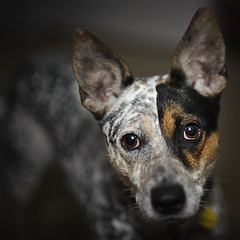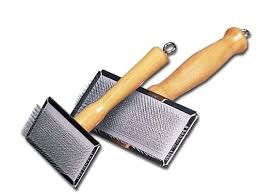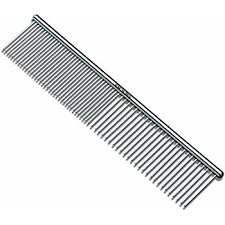Do Blue Heelers shed a lot
 The Blue Heeler or Australian Cattle Dog is a double-coated breed. This means they have a short guard coat of about one and a half inches in length that provides protection from rubbing up against things that they don’t shed. The second coat is the undercoat. The function of the undercoat is to keep them warm in colder weather. When the weather becomes warmer with the change of season they shed this undercoat to keep them cooler.
The Blue Heeler or Australian Cattle Dog is a double-coated breed. This means they have a short guard coat of about one and a half inches in length that provides protection from rubbing up against things that they don’t shed. The second coat is the undercoat. The function of the undercoat is to keep them warm in colder weather. When the weather becomes warmer with the change of season they shed this undercoat to keep them cooler.
They generally shed twice a year. However, this can vary depending on the climate they live in, whether they are an indoor or outdoor dog, whether they are neutered in the case of a male, and the overall health of their coat. Some Australian Cattle Dogs even shed all year round.
A neutered male often will only have a major shed once a year. An unspayed female will usually shed after they have been on heat. This is generally twice a year. As a female dog gets older they come into season less often.
The Blue Heeler can have a quite dense undercoat and they often shed large quantities of fur. When a double-coated dog is doing a major shed it is known as the coat is “blown”. This means the coat is coming out in clumps.
How to reduce Blue Heeler Shedding
You will never be able to completely stop a Blue Heeler, or any double-coated dog shedding. However, the amount of coat that they leave around the home or on your clothes can be reduced. These are some tips to help reduce the amount of coat your Australian Cattle dog sheds.
Regularly brush your Blue Heeler
The main thing you can do to reduce shedding is regularly brushing your dog. Brushing helps to remove excess and loose fur. It also redistributes your dog’s skin oil into the fur helping it to stay in place. Ideally, you should brush your Australian Cattle Dog daily during times they are doing a heavy moult. For other times, twice a week will suffice.
There are a few different types of deshedding tools such as Furninators, shedding blades and undercoat rakes. For the best brushes for a Blue Heeler see here. Be very careful when brushing your dog not to press too hard or do too much at once. You can cause brush burn on your dog’s skin. I recommend no more than 10 strokes in the same area.
A good stainless steel 50/50 comb or dematting comb is ideal to run through your dog’s coat after brushing to get any remaining dead undercoat the brush may not have picked up.
Regular bathing of your Blue Heeler
Regularly bathing will also help to loosen dead undercoat. Refer to How to bathe a dog for more information on how to bath. I recommend using a soap-free shampoo as you don’t want to dry out your dog’s skin and strip out the natural oils in your dog’s coat.
A lot of the fur will come out in the bath instead of on your furniture. Towel dry your dog with firm but gentle rubbing which will also help remove dead fur. Finally, blow-dry your dog using a low heat setting.
You can give your dog a good brush once dry and you will find it is easier to brush a clean coat than a dirty one. If you don’t have the time, energy or facilities to bathe and brush your dog regularly use a grooming service.
Also, keep up to date with flea treatment for your dog as constant scratching will also make coat come out.
Provide a high-quality diet
The third thing you can do is to ensure your dog’s coat remains healthy and they shed less is through a high-quality diet. These may cost a little more in the short-term but will improve your dog’s overall health and save on vet bills in the long-term.
Dogs with food allergies or sensitivities are particularly prone to diet-related shedding. You may need to experiment with a few different foods before you find one that’s right for your dog.
In addition, you can add Salmon oil, olive oil or flaxseed oil to your dog’s food. One teaspoon (5 mL) per 10 pounds (4.5 kg) of body weight is a good place to start. These oils contain omega-3 fatty acids that help calm inflamed skin, decrease dandruff, and improve overall coat texture.
You can also increase your dog’s omega-3 fatty acid intake by feeding it salmon, tuna, or other fish rich in these fatty acids. Finally, remember to ensure your dog has access to fresh water at all times. Dehydration can lead to dry skin, which can cause excessive shedding and even illness. Make sure your dog always has access to as much clean, fresh water as it wants to drink.
Best brush for Blue Heeler
Having the right tools for any job will make it easier and you can do a much better job. Just as a carpenter will not just use a hammer, having a selection of brushes will be much more effective.
For brushing and deshedding your Blue Heeler I recommend using a good quality slicker brush, a steel comb, and some type of deshedding tool. These are some suggestions for the best brush to use for grooming an Australian Cattle Dog.
Slicker Brush

The slicker brush is a pin brush which is used mainly as a dressing brush. This puts a shine on the coat and works well to loosen tangles and break the coat up to allow the other tools to finish the job.
50/50 Steel Comb

A good comb is an essential tool for anyone who grooms a dog. Once you have gone over the area with the slicker brush first, ran the de-matting comb through to remove any tangles you can comb through again, first with the wider teeth and then again with the finer teeth. If you can’t run the finer teeth of the comb through the coat without resistance the coat is not fully brushed out. Repeat the process until you can.
There are other types of steel comb available including some with a handle that some people find more comfortable to hold.
For our recommended deshedding tools for Blue Heelers see here.
Should you shave a Blue Heeler
Many people ask if they should shave their Australian Cattle Dog to stop shedding. I highly recommend NOT shaving a Blue Heeler.
This may result in increased shedding as the coat often grows back thicker producing more undercoat. Shaving a double-coated dog will permanently damage the guard coat often growing back thicker and uneven.
Some people even clip or shave a double-coated dog because they feel it will keep the dog cooler. In fact, this is not true. This actually interferes with the natural function of the coat. To learn more about whether to shave a Blue Heeler see here.
More Blue Heeler related topics –
How to exercise a Blue Heeler or Cattle Dog
Herding Breed Behavior Problems
Best Type of toys for Blue Heelers